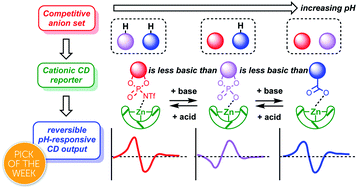Inducing a pH-dependent conformational response by competitive binding to Zn2+ of a series of chiral ligands of disparate basicity†
Abstract
Molecules that change shape in response to environmental conditions are central to biological molecular communication devices and their synthetic chemical analogues. Here we report a molecular system in which a series of chiral anionic ligands of differing basicity are selectively protonated according to the pH of the medium. A cationic circular dichroism (CD) reporter complex responds to anion binding by selecting one of two alternative enantiomeric conformations. Exploiting the principle that less basic anions have, in general, weaker electrostatic interactions than more basic anions, a set of three chiral acids with large (>5 unit) pKa differences and differing configurations were sequentially deprotonated in acetonitrile by addition of base, allowing the most basic anion in the mixture at any time to bind to the reporter complex. A characteristic CD output resulted, which changed in sign as the next-most basic anion was revealed by the next deprotonation in the series. Four cycles of switching between three ligand-bound states were achieved with minimal changes in signal magnitude, by alternating addition of base and acid. The pH-dependent conformational response was used to transduce a signal by appending to the binding site a 2-aminoisobutyric acid (Aib) oligomer, whose M or P helical conformation depended on the chirality of the bound ligand, and was reported by a remote 13C-labelled NMR reporter group. The multicomponent system thus converts a pH signal into a programmable conformational response which induces a remote spectroscopic effect.

- This article is part of the themed collections: 2022 ChemSci Pick of the Week Collection and 2022 Chemical Science HOT Article Collection


 Please wait while we load your content...
Please wait while we load your content...